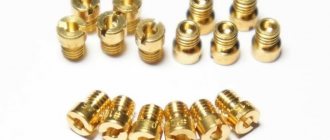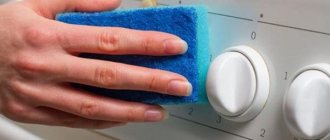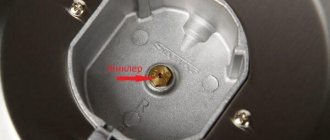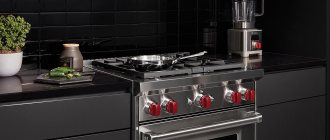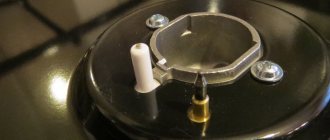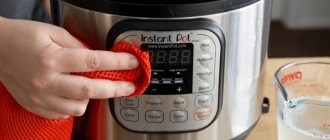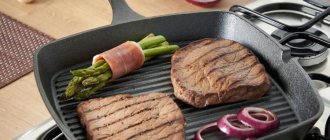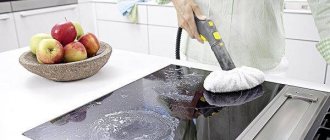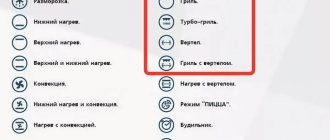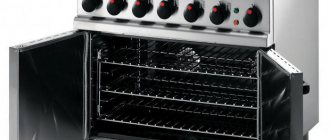It is possible to simplify the cleaning process as much as possible and achieve the desired result of shining gas stove grates only if the method and cleaning composition are correctly selected.
We will tell you in this article how to clean the grate of a gas stove from carbon deposits at home.
How to remove using folk remedies?
When cleaning gas stove grates, you should start with available means at hand (we save money and time spent on buying household chemicals).
Soda
Dry baking soda powder is a natural abrasive that perfectly cleans steel and cast iron rods.
Algorithm of actions:
- baking soda is diluted to a thick paste;
- the finished product is applied to the grill and left for thirty minutes;
- The treated surfaces are thoroughly rubbed with a brush or a hard sponge, and then washed off with warm water.
It is better to apply the baking soda paste to the slightly moistened surface of the rods.
Mustard
Fresh mustard or dry mustard powder is a gentle means for cleaning grates from carbon deposits (does not leave scratches or abrasions).
Algorithm of actions:
- Wipe the grill thoroughly with a damp cloth.
- Dry mustard is diluted with water to form a thick paste.
- The prepared mixture is applied to each rod and left for at least three hours.
- Treated surfaces are thoroughly wiped with a rag, hard sponge or brush.
There is no need to dilute fresh mustard with water before applying it to the grill.
Laundry soap and office glue
A product whose effectiveness has been tested by time is a mixture of soap and office glue.
The alkalis contained in the glue enhance the cleaning properties of soap, helping to dissolve hardened layers of fat and soot.
Algorithm of actions:
ten liters of water are poured into a bowl or large saucepan, in which 150 ml of office glue and a bar of laundry soap grated on a coarse grater are stirred;- place the prepared pan on the fire and bring its contents to a boil;
- I lower the dirty grates into boiling water and continue the boiling process for another hour;
- after sixty minutes, remove the pan from the heat, remove the grates, clean each rod with a stiff sponge or brush;
- the already cleaned surface is washed again under warm running water.
During the boiling process, make sure that the grate is completely immersed in water. The boiled liquid is added as needed.
Cleaning enamel grilles
Such grates look more attractive than their cast iron counterparts. They are light, not afraid of water and have a smooth shiny surface.
The enamel coating does not have increased resistance to mechanical damage. To protect the structure from scratches, it is better not to use aggressive detergents for cleaning. The product can be washed in the dishwasher if its dimensions allow.
To remove carbon deposits from the enamel grill in the dishwasher, you need to use the longest wash cycle with the highest possible temperature. Add more detergent than usual
Not everyone has a dishwasher, so we will figure out how to clean the enameled grate of a gas stove from fat and carbon deposits using improvised means.
No. 1 - a mixture of dry mustard and vinegar
Mustard has disinfectant properties and is able to break down fat. It is completely safe for health, so it can be used as a household cleaner.
Steps for cleaning the grille:
- Mix the ingredients: 3 spoons of 9% vinegar, 3 spoons of mustard powder, 1 spoon of dishwashing detergent.
- Using hot water, bring the substance to a pasty state.
- Apply the resulting product to the bars of the grill.
- Leave for 2-3 hours, depending on the degree of contamination of the product.
- Rub the structure with a washcloth and wash off the dirt.
Cleaning the grates in this way does not require large investments and is quite easy to do.
No. 2 - vinegar and water
Vinegar is good at cutting through grease and is often the main ingredient in many cleaning products. To clean the grate of a gas stove from carbon deposits, soak it in vinegar and water (1:1) and leave it overnight. Before the morning, the dirt will dissolve; you just need to rinse and dry the enamel structure.
No. 3 - melamine sponge
Mustard and vinegar work well with carbon deposits, but in both cases it takes at least 3 hours to complete the procedure.
And if guests are “on the doorstep” and you need to get rid of fat urgently, how can you quickly clean the grate of a gas stove? In such a situation, a melamine sponge will help.
Melamine sponge has recently appeared on the market. The product is expensive. But it is still a popular remedy because it allows you to effectively and quickly get rid of various surface contaminants.
Using a sponge is very simple: wet it with water, wipe the grill bars and rinse with clean water. Using the product, you can get rid of carbon deposits not only from enameled surfaces, but also from cast iron and even steel structures.
Using household chemicals
Special chemical compounds designed to remove stubborn fat deposits, soot and soot will quickly return the gas stove grate to its original appearance. There is a wide range of household chemicals on the shelves of hardware stores.
Gels carefully remove grease, do not leave scratches , and are ideal for any materials. When choosing a cleaning spray, you must carefully study the composition (high concentrations of acids and alkalis are dangerous for cast iron and enameled surfaces). Otherwise, the spray is very convenient to use; it helps to save product consumption by spraying it onto the surface through a special spray bottle.
Abrasive powders are attractive at a fairly low cost (an order of magnitude lower than the price of a gel or spray). But abrasive is not suitable for glossy surfaces. In other cases, before application, it is recommended to dilute the powder with water to form a thick paste.
TOP - the most effective means of removing carbon deposits from a gas stove grate:
Top House Grease Cleaner
Will dissolve without residue:
- congealed fat,
- soot,
- burnt food.
Polishing microgranules in the spray will return the original gloss to the gas stove grate. After using the spray, a protective film is formed on the surface, making subsequent cleaning easier.
A convenient spray bottle helps to save cleaning product consumption. The average cost is 400 rubles. (500 ml bottle). Read reviews here.
Mr. Chister
In just three minutes it will remove stubborn grease, soot and carbon deposits from the grate of a gas stove . It is enough to spray the composition onto the contaminated surface, wait a little and rinse with warm water. The average cost is 220 rubles. (500 ml bottle). Read reviews here, on this and this review site.
Grease remover spray Sanita
The product from a Russian manufacturer is suitable for removing particularly difficult contaminants (grease, soot, burnt food). Recommended for treating gas stove grates and other kitchen surfaces made of:
- become,
- cast iron,
- enamel,
- stainless steel
Simply spray the product onto the stain, wait one minute, and rinse with warm water. The average cost is 170 rubles. (500 ml bottle). Read reviews here, here and here.
You can work with household chemicals only after thoroughly studying the manufacturer’s instructions, in a well-ventilated area, using protective rubber gloves.
Cleaning the grill using traditional methods
While manufacturers are inventing new means to combat fat and carbon deposits, Russian housewives are not asleep and are using folk remedies. They are time-tested, cost pennies and do an excellent job with the dirty elements of a gas stove.
Using laundry soap
A non-standard recipe that uses office glue (not PVA) and 70% laundry soap. To remove dirt from the grates, use the following instructions:
- select a container of the required diameter and fill it with boiling water;
- grate the soap on a coarse grater and dissolve in a liter of hot water;
- add 150 ml of stationery glue;
- pour the prepared solution into a basin and place it on the fire;
- immerse the stove grate in water and “cook” for 1.5 hours;
- remove and immediately immerse in another container with cold water;
- Wipe the surface with steel wool.
The technique is suitable for cleaning steel gratings. Cast iron and enameled ones may deteriorate after a sharp temperature change.
Cleaning with ammonia
Ammonia will clean any grate, including cast iron. The product is found in every home, but the downside is that it has an unpleasant, pungent odor. However, the efficiency is captivating.
The recipe is simple.
- Remove the grate from the stove.
- Pour ammonia into a sprayer and spray the surface.
- Wrap in plastic wrap to prevent air from entering.
- Wait 2 hours.
- Wipe with a sponge soaked in detergent
This method removes grease and carbon deposits even in hard-to-reach places.
Heat treatment
Roasting metal with an open fire (calcination or heat treatment) is an excellent way to quickly clean the steel grates of a gas stove from dense layers of carbon deposits. This type of cleaning cannot be used for cast iron or enamel rods.
The steps are simple: using the open flame of a blowtorch, the burners of the gas stove burn the rods of the gas grate. Under the influence of high temperatures, the fat breaks down into tiny particles and all that remains is to wipe the surface with a clean damp cloth.
Universal ways to wash off fat and carbon deposits
For the manufacture of gas stove grates, the following is traditionally used:
- cast iron;
- stainless steel;
- enameled steel.
There are several universal and safe methods that can clean any of these materials.
The first folk remedy is soda
One of them is the use of baking soda. Moisten the product a little with water until a paste forms and coat the grate with it on all sides. Leave it to sit for about an hour so that the soda has time to dissolve the layer of dirt, then wipe thoroughly, first with a stiff brush and then with a sponge. The grate will become clean and shiny.
Regular baking soda is a universal remedy for cleaning grates on a gas stove.
Boiling water
Preheat oven to highest temperature. Pour water into a deep baking tray so that it completely covers the grate placed on it. Place the pan in the oven and wait. The water, heating up, will soften the burnt fat: it will simply fall away from the rods. After this, it will be enough to wipe the grill with a wet cloth, and if necessary, lightly walk with a scraper or a hard sponge.
Steam
For quick, gentle cleaning without the use of chemicals, which also does not require much effort, you can use a portable steam generator with a nozzle in the form of a hard round brush. A jet of hot steam perfectly softens grease stains, and the brush removes them from the surface.
A steam generator with a special nozzle will help you remove stubborn grease stains
The steam generator will help you effectively clean any grate, including non-removable grates.
Mustard
You can also use mustard powder to dissolve fat.
- Wet the grate.
- Apply a paste made of mustard powder and a little hot water on it.
- Leave for 2 hours.
- Rub with a hard sponge and rinse.
The property of mustard to break down fat has long been known, so it is successfully used as a cleaning and disinfectant.
Wire brush
Hard cleaning with metal brushes is suitable when the grate on the gas stove is not removable.
Algorithm of actions:
- the rods are moistened with water;
- using a stiff metal brush, scrape off dirt with active circular movements;
- The cleaned surface is wiped with a clean damp cloth.
You can simplify the mechanical cleaning process if you use a drill with a special brush attachment.
Cleaning cast iron
Cast iron grates are only available in expensive cookstoves. The material is distinguished by its high weight and long-lasting heat retention.
It is allowed to clean a cast-iron structure from carbon deposits in the following ways:
- Calcination. It is performed over an open fire, so the procedure is carried out outdoors or in a room with open windows. Additionally, it is recommended to turn on the hood, since carbon deposits release toxic elements into the air during combustion. You can use gas on the stove, burner or fire. The grate is held over an open fire. It must be constantly turned over, waiting for the thick fat layer to burn. Residues can be easily removed with a damp cloth.
- Engine oil . It corrodes any carbon deposits, so 10 minutes after application the layer easily comes off the metal. In this case, the integrity of the cast iron is not compromised.
- Metal brush. It can be replaced with a special drill attachment. But you cannot clean the product in this way too often, as this leads to destruction of the metal.
If you figure out how to clean the grate on a gas stove, you can easily remove thick deposits.
Cleaning features depending on the material
The first thing you need to do when starting to clean the gas stove grate is to find out what material it is made of. This knowledge directly influences the choice of cleaning method and type of detergent.
Cast iron
Cast iron rods are very difficult to maintain . Cast iron scratches very easily. Therefore, such products cannot be scraped with a knife or other sharp objects, or be beaten off the surface with a hammer. Cast iron does not withstand the aggressive effects of acidic compounds.
The best option for cast iron grates is cleaning with a steam generator or heat treatment (cast iron tolerates heat very well).
Stainless steel
Stainless steel gratings are resistant to chemicals and abrasives. Stainless steel is easy to clean from carbon deposits using a wire brush, sand or soda. It is enough to slightly moisten the metal with water, and then thoroughly rub the stains.
Enamel
Lightweight enamel-coated gratings are sensitive to rough mechanical and aggressive chemical influences.
The method of soaking in a soap solution will help remove carbon deposits from such surfaces . Dissolve 100 ml of liquid dishwashing detergent in 10 liters of water.
The frying pan is soaked in the resulting mixture for at least six hours, after which the dirt can be easily removed with a soft brush or sponge.
Effective ways to clean grates using home remedies
To determine how to clean the grate on a gas stove at home, it is necessary to take into account the characteristics of contamination, the condition of the grate and the properties of the material from which it is made.
The following remedies are recognized as the most common and effective.
- Fine river sand was used to clean dishes from scale and soot back in the days when people did not know about the existence of soap. Sand mixed with clay or ash was considered an excellent cleanser. If you replace ash and clay with 72% laundry soap, then mixed with fine sand you will get an excellent cleaning composition. However, it should not be used to clean enamel surfaces, since grains of sand may scratch the enamel coating.
- You can clean the grate of a gas stove with sodium bicarbonate. Baking soda is especially effective in removing dirt on enamel and steel surfaces. However, it is better to use it to remove old, but not thick layers of dirt.
- The grate can be cleaned well with baking soda and vinegar. If heavily soiled, steel and enameled grates must first be soaked in hot water with washing powder or foam from laundry soap. After this, wash with running water, and then treat with soda or vinegar. You can use a mixture of both. It is also possible to add mustard powder, which removes fat well.
- You can use ammonia to clean the grill. It is better to do this in a ventilated area or outdoors. It is advisable to use a respirator and gloves. Before you clean the grill with ammonia, you need to know the properties of this substance. Ammonia acts not only when applied to the surface, but also when sprayed in a confined space. You need to put a grate in a plastic bag, and then spray ammonia in it. Close the bag tightly and leave for 7 hours. After this, all that remains is to thoroughly wash the grille with water.
- You can clean any removable part of the stove from carbon deposits by immersing it in a hermetically sealed bag with a solution of soda, washing powder and mustard. By soaking removable parts in the bathtub, residual grease can be easily washed off. However, a more concentrated solution can be created in polyethylene, which will make the cleaning process more efficient.
Instructions: how to clean an artificial stone sink in the kitchen.
Slab gratings treated with the above methods must be dried or wiped dry with a clean absorbent cloth before use. The fact is that water mixed with vapors and liquids released during cooking contributes to the accelerated deposition of contaminants. Because of this, the stove will soon need cleaning again.
Before deciding how to clean the removable parts of the stove, you need to assess the nature of the contamination and the condition of the product. In addition, the choice of product is also influenced by how quickly you need to get rid of the accumulated dirt.
If the grate is soaked in bags, then the stove cannot be used for a long time.
Accelerated cleaning without soaking will only give results if the stains are not old. If multi-layered formations of burnt food have accumulated, then soaking can only be avoided by using strong remedies that are no longer considered folk remedies.
For example, some people clean stove grates with car engine cleaner. This is a strong and fast-acting remedy, but you can only work with it outdoors or in special rooms. In addition, after treating with this solution, the grate should not only dry out, but also be well ventilated. Otherwise, during cooking, particles of a substance hazardous to health will rise into the air of the living space, which is harmful to the health of people and pets.
How to prevent plaque from appearing?
To ensure that your gas stove grate always shines clean, you must follow these rules:
- Cleaning - after each cooking . There's nothing easier than wiping down the grill with a damp cloth at the end of the day. Spending two minutes on regular cleaning will save two hours on removing stubborn grease and grime.
- A chip-free surface means less dirt . The fewer scratches, abrasions and chips there are on the gas grill, the easier it is to keep it clean.
A life hack from experienced housewives: coarse salt, sprinkled on greasy stains immediately after they appear, prevents grease particles from attaching to the grate of the gas stove.
Cleaning a gas stove grate using home remedies
Situations when it is necessary to wash the grate of a gas stove from the remains of burnt food, greasy splashes, and soot from burning gas are typical for every kitchen. You should definitely not use anything sharp for this purpose (although this option is tempting, sharp objects seem like a good way to clean burnt areas...). But they can also permanently scratch the surface without ensuring thorough cleaning. Instead of this risky method, try using a well-known cleaner - vinegar. Treat contaminated areas with undiluted vinegar, leave overnight to soften and dissolve plaque. The next day after using the folk remedy, the grill can be washed by simply rinsing with water and a detergent added.
Are the products too dirty? Try cleansing with baking soda. Remove the grates, apply a paste of baking soda and water, and sprinkle with vinegar. The created foam will effectively dissolve carbon deposits. Clean with a sponge and wash with water.
Adviсe
A few tips from experienced housewives will make the difficult process of cleaning carbon deposits from gas grills easier:
- Fresh traces of soot can be easily removed with lemon juice. It is enough to wipe the rods with a slice of fresh citrus and there will be no trace of greasy stains left.
- The soaking time in the soap solution should not exceed six hours. Prolonged contact with water destroys the protective layer of metal rods.
- Liquid for washing car engines is an effective tool in the fight against carbon deposits on cast iron grates.
Life hack: using cookware with high sides helps keep the grates and work surface of the gas stove clean.
Methods and means for cleaning various surfaces from carbon deposits are presented in this section.
Taking into account the material
Now we will look at the most suitable cleaning methods for each type of grate separately. It is important to know what material the grate on your stove is made of, because the choice of how to care for it can directly depend on this.
Cast iron alloy
Cast iron as a material is not very convenient for cleaning. For example, a heavy and bulky cast iron rack should not be loaded into the dishwasher. You can try to simply scrape off the dirt with a knife or a stiff brush, but this is time-consuming and difficult, and scratches that are unpleasant to the eye may form on the surface.
Cast iron grates are not recommended to be washed in the dishwasher.
Calcination
The most effective way is to calcinate a cast iron grate over an open fire . It is best to do this in the country house or in the yard using a lit fire or a blowtorch. But you can calcine it at home, right over the gas stove.
- When burned, dried fat and dirt will emit a strong odor, so first open the windows and doors wide open and turn on the hood.
- Place a grate over a lit gas burner.
- Turn it from time to time so that all the ribs can be exposed to the fire.
- Keep it there until all the fat and dirt burns off.
- After calcination, wipe the cooled grate with a wet cloth and dry.
A variant of this method is calcination in sand.
- Place the wire rack on a large baking sheet (which you don't mind) or a metal sheet.
- Cover it with sand and place it on the fire. After a few hours, the greasy stains will burn off.
- Rinse the grill with water and dry.
Coarse river sand is the most affordable abrasive for cleaning grates.
Mechanical removal of contaminants
Another very effective method, although more expensive . Home craftsmen have figured out how to significantly simplify this process and do without tedious scraping.
- Buy an attachment in the form of a not very stiff metal brush for a drill or grinder at a hardware store.
- Install, turn on the device and move it along the grate in a circular forward motion.
This automated cleaning shows brilliant results. In addition, this method is good if the grate is non-removable or non-removable, designed for 4 burners.
Interesting! Liquid for washing car engines is excellent for removing stubborn dirt from cast iron grates. Wet the sponge thoroughly with it and thoroughly wipe the product on all sides, especially where there is more dirt. After this, rinse the grill in running water and dry.
Stainless and enamelled steel
Steel grates can be cleaned of congealed grease and related contaminants either directly on the stove or in the bathroom. For stainless steel, you can use any aggressive detergents, including abrasives. But enamel requires more careful treatment. It is not recommended to scrape such a grill with a metal scraper, much less a knife: enamel surfaces are susceptible to scratches and chips.
You cannot clean the enamel with a knife or a hard metal brush mounted on a drill: the risk of getting chips and scratches, which will later become covered with rust, is very high
If you are going to use caustic chemicals, wear safety glasses and a medical mask if possible. This way you will protect the mucous membranes of your eyes and respiratory tract from toxic fumes.
Chemicals
Gels marked “Anti-grease” are best suited for steel gratings..
- Apply a generous layer of this substance evenly to the surface of the grate.
- Follow the exposure time specified in the instructions.
- If necessary, scrub the grate with a sponge and then rinse under running water.
The steel grate is highly resistant to aggressive chemicals.
Don’t forget: no matter what method you choose, no matter what means you use, always wear rubber gloves when working in the kitchen. Both chemical and natural substances (what can I say, even ordinary water) with prolonged exposure negatively affect the health of the skin of the hands.
Vinegar
You can also dissolve fat using vinegar:
- Place a deep baking tray on an open balcony or in the yard.
- Place a wire rack in it and fill it with vinegar.
- Leave for several hours.
- When all the grease has dissolved, wipe off any remaining dirt with a rag.
Concentrated acetic acid must be diluted with water according to the instructions on the label.
Important! If the product you are using has a pungent odor, do not work with it indoors, open a window or go out into the open air. And do not leave the treated grill for long, so as not to breathe in toxic fumes. Follow label instructions.
Soap solution
The classic method is simple and accessible, but requires the most time and effort.
- In a large basin or other container with a suitable volume, prepare a strong soap solution from shavings of laundry soap or any strong dishwashing detergent. You need to take hot water.
- Place your stove grate in this solution and leave to soak overnight.
- In the morning you can easily wipe off dirt with an iron scraper or a hard sponge.
Soak the steel grate in a saturated soap solution for at least 12 hours, and then you can easily wipe off burnt grease
Melamine sponge
Having recently appeared on the market, melamine sponges have already become popular among housewives due to the fact that they easily and carefully deal with most stains. You need to use this miracle remedy in this way:
- Wet the sponge with water.
- Rub dirty areas on the grill bars.
- Remove the foam with a dry cloth.
This method is great for cleaning hard-to-reach places, especially around non-removable grilles.
The substances that make up the melamine sponge do an excellent job of removing any dirt.
Dishwasher safe
This method is simple and ideal for enamel. Just remember to remove all plastic and rubber parts, if any, from the grill before loading it into it. And add more detergent than usual, especially in case of fairly strong and old stains.
To make subsequent cleanings much easier and less troublesome, use a little trick: create a protective coating on the grille. Apply a mixture of 2 parts office silicate glue, 1 part any washing powder and 6 parts soda ash to the bars of a clean grill, dry and rinse.
Soda ash with the addition of silicate glue and washing powder will help you avoid heavy contamination on the grill.
Note! Be sure to thoroughly dry the grate after cleaning; do not place it on the stove while wet. Grease sticks very easily to wet areas.
Types of gas stove grates
Before you understand how to clean the grate on a gas stove and choose one of the proposed methods, you need to carefully study the instructions for the device to find out for sure what material this part is made of. The grate of a gas stove can be metal, cast iron or steel; for each there are at least 5 effective ways to clean carbon deposits.
Cast iron grate
They are distinguished by their strength, heavy weight, and durability. The main advantage of a cast iron grate on a gas stove, which can be cleaned at home, is its reasonable cost. Such a cast iron part retains heat remarkably well, but, most importantly, does not sag under the weight of pots or pans. However, cleaning the cast iron grate on a gas stove will require some effort. Remember that prolonged exposure to water and scraping off fat with sharp objects or strong abrasives will negatively affect cast iron and lead to peeling of the material.
Enameled steel grille
Made of durable metal coated with special enamel. They have a lot of advantages:
- aesthetics;
- ease;
- water resistance.
You can clean such an enameled gas stove grate from grease and carbon deposits using a brush with soft or medium-hard hair. It is also not contraindicated to use household chemicals. Strong abrasive products are not contraindicated for cleaning the gas stove grate from gas deposits at home. Nevertheless, you should not get carried away with them, otherwise the life of the product will be significantly reduced.
Stainless steel grid
Experienced housewives will confirm that this material is the most durable. Such a gas stove grate can be washed without fear under running water or cleaned with a brush using even the most caustic detergent. It is stainless steel that is chosen by manufacturers of modern gas stoves as a material for grates. There are more than 5 best ways to help clean such a grate on a gas stove quickly and efficiently.
Products for any occasion that will help clear fat
Before understanding how to clean the stove grate, it is important to determine what material it is made of. The selection of tools that are used to solve this problem depends on this.
Typically, grates are made of cast iron, stainless steel and enameled steel. Cast iron products tend to be the heaviest, and their rods do not sit above the burner. Let's look at effective products that will help you clean your grill easily and efficiently.
A convenient way to clean the grill is in the dishwasher. But it is only suitable for stainless steel and enamel-coated products. Cast iron ones rust after being washed in the dishwasher.
Methods:
- Structures made of steel and coated with enamel are immersed in the dishwasher, then an intensive washing mode is set, using a double dose of a special detergent. If the grate is not clean enough, the process is repeated. At the end of the cycle, turn on the drying mode.
- A steam cleaner will help you clean your cast iron grate. It is enough to keep the structure under steam for a few minutes, which will easily soften the layer of fat. After this, carbon deposits can be easily removed with ordinary detergents and a brush.
Let's look at how to clean the stove grate from carbon deposits at home using universal products. They will help remove complex stains, are not as toxic as special liquids and gels, and are also cheaper.
These products include mustard powder, soda, vinegar, ammonia, and laundry soap.
The gas stove grate can be made from the following materials:
- steel with enamel coating;
- cast iron;
- stainless steel
Each metal has special properties, so different products are needed to remove fat from each of them. A woman cannot always remember what it is made of. In this case, you can use one of the universal recipes.
The components for preparing a cleaning composition can be found in any home.
The easiest way to remove carbon deposits from a grate is to use a dishwasher. It is suitable if it consists of several parts that fit in the dishwasher.
The owner just has to place the parts in the machine and turn on the longest mode at the highest temperature.
If the layer of fat is small, the rack is taken out of the dishwasher already clean. If carbon deposits have accumulated over the years, being in the dishwasher will soften the dirt and it can be easily removed with a regular sponge.
Another universal method involves using a household steamer. The grate is removed, placed vertically and exposed to a stream of steam for several minutes. After the carbon deposits have softened, remove them with a cloth or sponge and dishwashing detergent.
If you don’t have a dishwasher or steamer at home, or the grill cannot be disassembled or removed, you can remove carbon deposits using simple homemade remedies:
- Baking soda.
The powder is diluted with warm water, you should get a thick paste, which is covered with the grate and left for 30-50 minutes. During this time, the sodium carbonate will react with the fat and soften the plaque. The housewife will only have to treat the metal, first with a hard sponge and then with an ordinary sponge.
- Mustard.
It is better not to use ready-made seasoning, but to take the powder and make a paste from it yourself. Mustard has been used for centuries as a cleanser and disinfectant. Cover the metal rods with warm paste and leave for 2-3 hours. To prevent the composition from drying out, the grate can be placed in a garbage bag and tied tightly. After a few hours, the fat can be easily separated under running hot water using a sponge.
- Boiling water.
You can remove grease from any metal without compromising its quality using an oven. To do this, fill a deep baking tray with ordinary water, place a wire rack on top and put everything in the oven, turned on at maximum power. After half an hour of boiling, the carbon deposits will separate without much effort.
- Silicate glue and washing powder.
This is a folk method that our mothers and grandmothers used to effectively cleanse fat and carbon deposits. Dissolve 50 ml of glue in half a liter of warm water, add 6 tablespoons of regular or soda ash and a handful of washing powder. The grid is placed in a large bag made of durable polyethylene and left for several hours.
These methods are suitable for dirty gas stove grates made of any material.
We suggest you familiarize yourself with how you can descale your iron.
https://www.youtube.com/video/CiU-qBdVqPk
Cast iron materials are mainly supplied to expensive gas stoves.
This heavy metal retains heat well, but is very fragile, so it must be cleaned very carefully.
In addition to the above methods, there are several specific methods:
- Calcination over an open fire.
This is how our grandmothers cleaned cast iron frying pans, after which they became as good as new. It is better to use this method outdoors or at home with the windows open and the hood turned on, since the combustion of plaque releases many toxic substances. The grate is held over an open fire (burner or campfire), periodically turning over, until most of the soot has burned off. Residues can be removed with a damp cloth.
- Product for automobile engines.
After applying the liquid to cast iron rods, the carbon deposits are removed within a few minutes, without deteriorating the condition of the metal.
- You can also remove grease deposits from a cast iron grate using a metal brush or a drill attachment. However, you should not use this method often, because this will erase the top layer of metal.
Stainless steel gratings are highly durable and resistant to chemicals and abrasives, so you can use any, even the most aggressive, compounds to clean them.
This grill can be cleaned mechanically using regular sand, soda or a wire brush. To do this, you need to slightly moisten the metal and rub it for a few minutes.
After using abrasives, small scratches may remain, but they do not affect the operation of the grille at all.
There are more gentle ways to remove fat from stainless steel using homemade pastes:
- Soak regular washing powder (100 grams) with ammonia (30 ml) and apply to the metal for 15-20 minutes.
- Soda ash or baking soda is mixed with hydrogen peroxide until a thick paste is obtained. Rub the resulting mixture onto the grate with a coarse sponge and rinse off with running water.
- Pour mustard powder with an equal amount of vinegar (9%), add a little dishwashing liquid. The gruel is applied to the grill for a quarter of an hour, then cleaned with a sponge in hot water.
Some owners of gas stoves use one little-known product that facilitates the cleaning process in the future. To prepare it, you need transparent stationery glue (50 ml), baking soda (150 grams), washing powder or liquid detergent (1-2 tablespoons). All ingredients are mixed and the resulting mixture is coated on a clean grill. After drying, it becomes transparent; if necessary, it can be easily removed along with carbon deposits in hot water.
Such grates are usually equipped with budget models of gas stoves. They are light and durable, but the coating is very sensitive to mechanical and chemical influences.
To remove fat from such a grate, you will need gentle methods:
- Make a few liters of concentrated soap solution and soak the grate in it for several hours, or better yet, overnight. Contamination can be easily removed under water and with a regular sponge.
- Mustard and vinegar paste, the recipe for which is described above.
- Not long ago, melamine sponges appeared on sale. They are more expensive than usual, but they easily and carefully remove any dirt, even thick deposits of grease and dust on kitchen stoves. To do this, you just need to moisten the sponge with water and rub the dirt.
Manufacturers of household chemicals produce products for cleaning stains in the kitchen labeled “Anti-grease.” When choosing, you need to take into account the grate material; for stainless steel they produce a special series that preserves the shine of the products.
Professional products differ in price and method of application (gel, spray).
A universal product, suitable for all surfaces. The cream is applied with a sponge, rubbed in and left to act for 10-15 minutes.
An affordable product made in Russia, available in the form of a gel and spray. Dissolves grease in a few minutes and destroys all germs on treated surfaces.
Quite an expensive product made in Israel. It quickly dissolves all contaminants, but has a negative effect on the skin and respiratory system, so it is recommended to work with it in a respirator and with open windows.
Fast-acting, safe gel. The soot dissolved by it is removed with a regular sponge. The only disadvantage we can highlight is the high cost.
The spray belongs to the middle price category, is easy to apply, and works in a quarter of an hour.
All products contain acids and other aggressive components that quickly dissolve plaque, so you need to work in durable rubber gloves with ventilation turned on.
